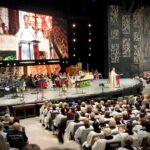- Ven. John Hassan
- September 3, 2020
- 0 Comments

Losing a fortune in the Chicago fire of 1871 was just the beginning of Horatio Spafford’s agony. Two years later a transatlantic shipwreck claimed the lives of his four daughters. In his deep grief, he penned the words of the cherished hymn “It Is Well with My Soul.”
For many who happen upon Spafford’s words today, the beautiful melody automatically begins playing in their heads. The soothing cadence forces them to slow down and take the words to heart, perhaps comforting them in their own anguish…
“When peace like a river, Attendeth my way,
When sorrows, Like sea billows roll;
Whatever my lot, Thou hast taught me to say,
‘It is well, It is well, with my soul.’”
Why Use Poetry?
Christians find encouragement not only from familiar poetic hymns of recent centuries, but also in beloved Old Testament poetic passages from millennials past.
Our current times may have lost an appreciation for the beauty of poetic verse, but “in most ancient [cultures], poetry was a highly prized mode of expression. Whole national epics and key historical and religious memories were preserved in poetry.”[i]
- Poetry was more easily memorized over prose “in an age where reading and writing were rare skills and where the private ownership of written documents was virtually unknown.”[ii]
- Although lines in poetry may appear repetitive, this device slows the reader down to ponder and meditate on the poem’s message.
- Worshipers of God used this genre to write lyrics that spoke to the depths of human emotions and myriad life experiences: laments of trust when in agony and confusion; testimonies of joy and praise for Yahweh’s healing, provision, or intervention; and to proclaim Yahweh’s messages given through his prophets.
In most ancient cultures, poetry was a highly prized mode of expression.
Where Do We Find Hebrew Poetry in the Bible?
Biblical scholars estimate over one-third of the Hebrew Old Testament is composed of poetry. The Author of scripture used this genre to write smaller passages and even entire books:
- Portions of the Old Testament Law: see the Song of Moses in Exodus 15:1-18 and the Blessing of Moses in Deuteronomy 33:1-29.
- Portions of the Old Testament Historical Narratives: see the Song of Deborah in Judges 5:1-31 and the Song of Hannah in 1 Samuel 2:1-10.
- Large portions of the Old Testament Wisdom books: see Job chapters 3-41 and the book of Song of Songs.
- The book of Psalms.
- Portions of the Old Testament Prophets: see King Hezekiah’s song in Isaiah 38:9-20, the book of Obadiah, and the prayer of Habakkuk in Habakkuk 3:1-19.
Biblical scholars estimate over one-third of the Hebrew Old Testament is composed of poetry.
What Are the Literary Characteristics of Hebrew Poetry?
The original audience would have easily recognized and understood the mechanics of this form of poetry; however, contemporary Christians must be careful not to interpret this ancient genre through a twenty-first century lens. Although Ancient Hebrew poetry and contemporary English poetry both use imagery through personification, simile, and metaphor, stark differences exist between the two. In Hebrew poetry:
- The entire text of a poem needs to be treated as a whole to understand the meaning of individual lines. Lifting a verse out of context will construe the meaning.
- The poets did not focus on rhyming the end of lines.
- Meter was not important.
The Three Prominent Features of Hebrew Poetry:
(1) Parallelism. Parallelism is the dominant characteristic of this genre. Bernhard Anderson explains, “Parallelism is the construction of symmetrical lines so two lines correspond, as in A and B, or even sometimes three lines, as in A, B, C. The function of the second line is to continue, expand, and reinforce a single thought, that is, A + B.[iii] This feature can create a sense of rhythm, but this is not the same as meter. As parallel lines follow one another in succession, a story begins to unfold through the poem.
For example, Psalm 19:1-2 reads:
(Line A): The heavens declare the glory of God;
(Line B): the skies proclaim the work of his hands.
(Line A): Day after day they pour forth speech;
(Line B): night after night they reveal knowledge.[iv]
(2) Terseness. Terseness refers to the use of a succinct number of words. In biblical Hebrew, the subject-verb-object could be reflected through one Hebrew word. Compactness of expression heightened the emotional impact on the audience and contributed to the energy of the poetry.[v]
For example, in the original language, the first line of Psalm 25:4 consists of only three Hebrew words and the second line of only two Hebrew words:
Show me your ways, LORD,
teach me your paths.
(3) Imagery. This characteristic was accomplished by using “the discourse of the heart” through figurative language, metaphor, similes, hyperbole, raw emotions, and analogy.[vi]
For example, Isaiah 1:18 reads:
Though your sins are like scarlet,
they shall be as white as snow.
Guidelines When Reading Hebrew Poetry
C.S. Lewis wrote, “Most emphatically the Psalms must be read as poems: as lyrics, with all the licences and all the formalities, the hyperboles, the emotional rather than logical connections, which are proper to lyric poetry. … Otherwise we shall miss what is in them and think we see what is not.”[vii]
- Ancient Hebrew poetry followed ancient literary rules, not modern.
- Keep the historical context in mind.
- The vocabulary was purposefully metaphorical; therefore, one cannot interpret the text hyperliterally. What was the intent or image behind the metaphor?
- Identify who was speaking in a verse… God? an individual person? or the Israelite community?
- Identify who was being spoken to in a verse… God? the ancient audience? or both?
- Each language has its own elements and semantics. Unfortunately, whenever poetry is translated from one language into another, some poetic properties are lost: for example, acrostics using the Hebrew alphabet.
The Beauty of Hebrew Poetry
During a time of personal crisis, a friend encouraged me that God was with me, and I knew this to be true. However, overwhelmed by my pain and fears, I turned to scripture and slowly read Psalm 23…
The LORD is my shepherd, I lack nothing.
He makes me lie down in green pastures,
he leads me beside quiet waters,
he refreshes my soul. …
Even though I walk
through the darkest valley,
I will fear no evil,
for you are with me.
The poetic imagery spoke to my mind and my heart. My Shepherd was with me in a supernatural way. As I remembered He was watching over me and guiding me, my heart calmed. Renewed focus on the truth of his gentle care and provision were quiet waters that refreshed my soul.
The passages of Hebrew poetry within the pages of scripture affirm the rawest human emotions, and yet do not leave one in the depths of despair.
The passages of Hebrew poetry within the pages of scripture affirm the rawest human emotions, and yet do not leave one in the depths of despair. The imagery of this genre nurtures the imagination, and yet renews and refocuses the mind on the One worthy to be served and worshiped. God’s people cry out in repentance with King David, and yet at other times they shout praises to the Lord with Mary in her Magnificat.[viii] Through these poetic testimonies, laments, and messages, the Almighty Creator assures Christians of his omnipotent and loving Presence during their own pilgrimages through history.
(https://www.rzim.org/read/rzim-global/reading-the-psalms-and-other-ancient-hebrew-poetry)
Note: For more specific discussions on interpreting Hebrew poetry, see article on Psalm 91.
[i] Gordon Fee and Douglas Stuart, How to Read the Bible for All Its Worth, pages 197-198.
[ii] Ibid.
[iii] Bernhard Anderson, Out of the Depths, pages 23-24.
[iv] Unless otherwise noted, all scripture verses are from the NIV.
[v] Anderson, page 24.
[vi] Rolf Jacobson in The Book of Psalms by Nancy deClaisse-Walford, Rolf A. Jacobson, and Beth LaNeel Tanner in The New International Commentary of the Old Testament, page 42.
[vii] Reflections on the Psalms by C.S. Lewis, page 3 or 31.
[viii] Psalm 51 and Luke 1:46-55.









